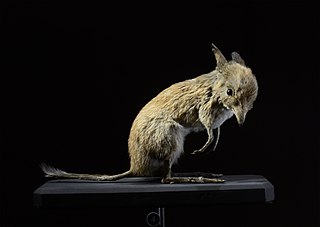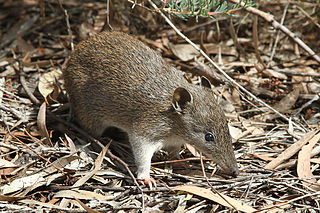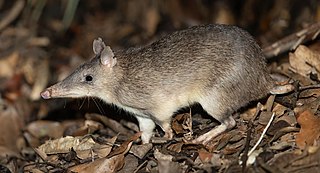
Macrotis is a genus of desert-dwelling marsupial omnivores known as bilbies or rabbit-bandicoots; they are members of the order Peramelemorphia. At the time of European colonisation of Australia, there were two species. The lesser bilby became extinct in the 1950s; the greater bilby survives but remains endangered. It is currently listed as a vulnerable species. It is on average 55 cm (22 in) long, excluding the tail, which is usually around 29 cm (11 in) long. Its fur is usually grey or white, it has a long pointy nose and very long ears, hence earning its nick-name, the rabbit-eared bandicoot.

The greater bilby, often referred to simply as the bilby since the lesser bilby became extinct in the 1950s, is an Australian species of nocturnal omnivorous animal in the order Peramelemorphia. Other vernacular names include dalgyte, pinkie, or rabbit-eared bandicoot. Greater bilbies live in arid parts of northwestern and central Australia. Their range and population is in decline.

The order Peramelemorphia includes the bandicoots and bilbies; it equates approximately to the mainstream of marsupial omnivores. All members of the order are endemic to the twin land masses of Australia-New Guinea and most have the characteristic bandicoot shape: a plump, arch-backed body with a long, delicately tapering snout, very large upright ears, relatively long, thin legs, and a thin tail. Their size varies from about 140 grams up to 4 kilograms, but most species are about one kilogram, or the weight of a half-grown kitten.

Bandicoots are a group of more than 20 species of small to medium-sized, terrestrial marsupial omnivores in the order Peramelemorphia. They are endemic to the Australia–New Guinea region, including the Bismarck Archipelago and, marginally, in Indonesia (Seram).

Liasis is a genus of pythons found in Indonesia, New Guinea and Australia. Currently, three extant species are recognized and one giant fossil species L. dubudingala, estimated to have been around 10 m (33 ft) in length.

The Darling Downs is a farming region on the western slopes of the Great Dividing Range in southern Queensland, Australia. The Downs are to the west of South East Queensland and are one of the major regions of Queensland. The name was generally applied to an area approximating to that of the Condamine River catchment upstream of Condamine township but is now applied to a wider region comprising the Southern Downs, Western Downs, Toowoomba and Goondiwindi local authority areas. The name Darling Downs was given in 1827 by Allan Cunningham, the first European explorer to reach the area and recognises the then Governor of New South Wales, Ralph Darling.

Chaeropus, known as the pig-footed bandicoots, is a genus of small mammals that became extinct during the twentieth century. The species were unique marsupials, of the order Peramelemorphia, that had unusually thin legs yet were able to move rapidly. There are two recognised species of these marsupials, which inhabited dense vegetation on the arid and semi-arid plains of Australia. The distribution range of the genus was later reduced to an inland desert region, where it was last recorded in the 1950s; it is now presumed to be extinct.
The New Guinean long-nosed bandicoots are members of the order Peramelemorphia. They are small to medium-sized marsupial omnivores native to New Guinea.

Perameles is a genus of marsupials of the order Peramelemorphia.

The short-nosed bandicoots are members of the order Peramelemorphia. These marsupials can be found across Australia, although their distribution can be patchy. Genetic evidence suggests that short-nosed bandicoots diverged from the related long-nosed species around eight million years ago, during the Miocene epoch, and underwent a rapid diversification around three million years ago, during the late Pliocene.
Quinkana is an extinct genus of mekosuchine crocodylians that lived in Australia from about 24 million to about 40,000 years ago. By the Pleistocene, Quinkana had become one of the top terrestrial predators of Australia, possessing long legs and ziphodont teeth. Quinkana comes from the "Quinkans", a legendary folk from Aboriginal myths.

Palorchestes is an extinct genus of terrestrial, herbivorous marsupials of the family Palorchestidae. The genus was endemic to Australia, living from the Miocene through to the Pleistocene epochs.

The long-nosed bandicoot is a species of bandicoot found in eastern Australia, from north Queensland along the east coast to Victoria. Around 40 centimetres (16 in) long, it is sandy- or grey-brown with a long snouty nose. Omnivorous, it forages for invertebrates, fungi and plants at night.

Elseya is a genus of large side-necked turtles, commonly known as Australian snapping turtles, in the family Chelidae. Species in the genus Elseya are found in river systems in northern and northeastern Australia and throughout the river systems of New Guinea. They are identified by the presence of alveolar ridges on the triturating surfaces of the mouth and the presence of a complex bridge strut.
The Bluff Downs giant python is an extinct species of snake from Queensland, Australia, that lived during the Early Pliocene.
Perameles bowensis is an extinct Pliocene-aged species of bandicoot. Fossils have been found in the Wellington Caves of New South Wales. The bandicoot was about 20 centimeters long. It is believed to have gone extinct in the Late Pliocene.
The Bluff Downs fossil site is a paleontological site of Pliocene age in northern Queensland, Australia, and is the most significant fossil site of the Pliocene age in Australia. The fossil site lies on the banks of Allingham Creek on the pastoral property of Bluff Downs Station.
Elseya nadibajagu is a Pliocene species of extinct Australian snapping turtle, described from the Bluff Downs region of Queensland, Australia.
Crash bandicoot is an extinct marsupial bandicoot, known from fossils located at the Riversleigh World Heritage Area in northeast Australia.
Palorchestes selestiae is a fossil species of Diprotodontidae, ancient mammals that existed in Australia.











